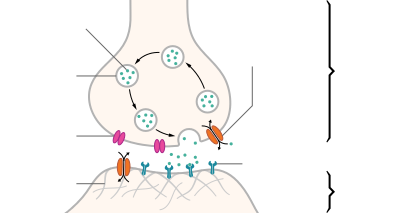Uptake carrier
| Structure of a typical chemical synapse |
|---|
Neurotransmitter transporters are a class of membrane transport proteins that span the cellular membranes of neurons. Their primary function is to carry neurotransmitters across these membranes and to direct their further transport to specific intracellular locations. There are more than twenty types of neurotransmitter transporters.
Vesicular transporters move neurotransmitters into synaptic vesicles, regulating the concentrations of substances within them. Vesicular transporters rely on a proton gradient created by the hydrolysis of adenosine triphosphate (ATP) in order to carry out their work: v-ATPase hydrolyzes ATP, causing protons to be pumped into the Synaptic vesicles and creating a proton gradient. Then the efflux of protons from the vesicle provides the energy to bring the neurotransmitter into the vesicle.
Neurotransmitter transporters frequently use electrochemical gradients that exist across cell membranes to carry out their work. For example, some transporters use energy obtained by the cotransport, or symport, of Na+ in order to move glutamate across membranes. Such neurotransporter cotransport systems are highly diverse, as recent development indicates that uptake systems are generally selective and associate with a specific neurotransmitter.
Normally, transporters in the synaptic membrane serve to remove neurotransmitters from the synaptic cleft and prevent their action or bring it to an end. However, on occasion transporters can work in reverse, transporting neurotransmitters into the synapse, allowing these neurotransmitters to bind to their receptors and exert their effect. This "nonvesicular release" of neurotransmitters is used by some cells, such as amacrine cells in the retina, as a normal form of neurotransmitter release.
...
Wikipedia

